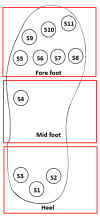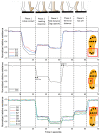Flexible Ultra-Thin Nanocomposite Based Piezoresistive Pressure Sensors for Foot Pressure Distribution Measurement
- PMID: 34577285
- PMCID: PMC8471841
- DOI: 10.3390/s21186082
Flexible Ultra-Thin Nanocomposite Based Piezoresistive Pressure Sensors for Foot Pressure Distribution Measurement
Abstract
Foot pressure measurement plays an essential role in healthcare applications, clinical rehabilitation, sports training and pedestrian navigation. Among various foot pressure measurement techniques, in-shoe sensors are flexible and can measure the pressure distribution accurately. In this paper, we describe the design and characterization of flexible and low-cost multi-walled carbon nanotubes (MWCNT)/Polydimethylsiloxane (PDMS) based pressure sensors for foot pressure monitoring. The sensors have excellent electrical and mechanical properties an show a stable response at constant pressure loadings for over 5000 cycles. They have a high sensitivity of 4.4 kΩ/kPa and the hysteresis effect corresponds to an energy loss of less than 1.7%. The measurement deviation is of maximally 0.13% relative to the maximal relative resistance. The sensors have a measurement range of up to 330 kPa. The experimental investigations show that the sensors have repeatable responses at different pressure loading rates (5 N/s to 50 N/s). In this paper, we focus on the demonstration of the functionality of an in-sole based on MWCNT/PDMS nanocomposite pressure sensors, weighing approx. 9.46 g, by investigating the foot pressure distribution while walking and standing. The foot pressure distribution was investigated by measuring the resistance changes of the pressure sensors for a person while walking and standing. The results show that pressure distribution is higher in the forefoot and the heel while standing in a normal position. The foot pressure distribution is transferred from the heel to the entire foot and further transferred to the forefoot during the first instance of the gait cycle.
Keywords: bio-medical applications; flexible sensors; foot pressure distribution; gait analysis; multi carbon nanotubes (MWCNT); nanocomposite sensors; polydimethylsiloxane (PDMS); pressure sensor; wearable sensors.
Conflict of interest statement
The authors declare no conflict of interest.
Figures
















Similar articles
-
3D-Printable Carbon Nanotubes-Based Composite for Flexible Piezoresistive Sensors.Materials (Basel). 2020 Dec 1;13(23):5482. doi: 10.3390/ma13235482. Materials (Basel). 2020. PMID: 33271994 Free PMC article.
-
Strain and Pressure Sensors Based on MWCNT/PDMS for Human Motion/Perception Detection.Polymers (Basel). 2023 Mar 10;15(6):1386. doi: 10.3390/polym15061386. Polymers (Basel). 2023. PMID: 36987168 Free PMC article.
-
Flexible Piezoresistive Tactile Sensor Based on Polymeric Nanocomposites with Grid-Type Microstructure.Micromachines (Basel). 2021 Apr 16;12(4):452. doi: 10.3390/mi12040452. Micromachines (Basel). 2021. PMID: 33923849 Free PMC article.
-
Review on Conductive Polymer/CNTs Nanocomposites Based Flexible and Stretchable Strain and Pressure Sensors.Sensors (Basel). 2021 Jan 6;21(2):341. doi: 10.3390/s21020341. Sensors (Basel). 2021. PMID: 33419047 Free PMC article. Review.
-
Toward flexible piezoresistive strain sensors based on polymer nanocomposites: a review on fundamentals, performance, and applications.Nanotechnology. 2024 May 7;35(29). doi: 10.1088/1361-6528/ad3e87. Nanotechnology. 2024. PMID: 38621367 Review.
Cited by
-
Rational Design of Flexible Mechanical Force Sensors for Healthcare and Diagnosis.Materials (Basel). 2023 Dec 26;17(1):123. doi: 10.3390/ma17010123. Materials (Basel). 2023. PMID: 38203977 Free PMC article. Review.
-
A wireless, self-powered smart insole for gait monitoring and recognition via nonlinear synergistic pressure sensing.Sci Adv. 2025 Apr 18;11(16):eadu1598. doi: 10.1126/sciadv.adu1598. Epub 2025 Apr 16. Sci Adv. 2025. PMID: 40238890 Free PMC article.
-
Soft CNT-Polymer Composites for High Pressure Sensors.Sensors (Basel). 2022 Jul 14;22(14):5268. doi: 10.3390/s22145268. Sensors (Basel). 2022. PMID: 35890946 Free PMC article.
-
Microfluidic Wearable Devices for Sports Applications.Micromachines (Basel). 2023 Sep 19;14(9):1792. doi: 10.3390/mi14091792. Micromachines (Basel). 2023. PMID: 37763955 Free PMC article. Review.
-
Sensors, Circuits, and Systems for Biomedical Applications.Sensors (Basel). 2023 Mar 21;23(6):3295. doi: 10.3390/s23063295. Sensors (Basel). 2023. PMID: 36992007 Free PMC article.
References
-
- International Diabetic Federation Ninth IDF Diabetes Atlas, 9th ed. [(accessed on 2 May 2021)]. Available online: https://www.diabetesatlas.org/
-
- Barkley R.M., Bumgarner M.R., Poss E.M., Senchina D.S. Physiological versus perceived foot temperature, and perceived comfort, during treadmill running in shoes and socks of various constructions. Am. J. Undergrad. Res. 2011;10:7–14. doi: 10.33697/ajur.2011.019. - DOI
-
- Prompers L., Huijberts M., Schaper N., Apelqvist J., Bakker K., Edmonds M., Holstein P., Jude E., Jirkovska A., Mauricio D., et al. Resource utilisation and costs associated with the treatment of diabetic foot ulcers. prospective data from the eurodiale study. Diabetologia. 2008;51:1826–1834. doi: 10.1007/s00125-008-1089-6. - DOI - PubMed
-
- Oliveira S.S., Pannuti C.M., Paranhos K.S., Tanganeli J.P., Laganá D.C., Sesma N., Duarte M., Frigerio M.L.M., Cho S.-C. Effect of occlusal splint and therapeutic exercises on postural balance of patients with signs and symptoms of temporomandibular disorder. Clin. Exp. Dent. Res. 2019;5:109–115. doi: 10.1002/cre2.136. - DOI - PMC - PubMed
MeSH terms
Substances
Grants and funding
LinkOut - more resources
Full Text Sources
Miscellaneous

